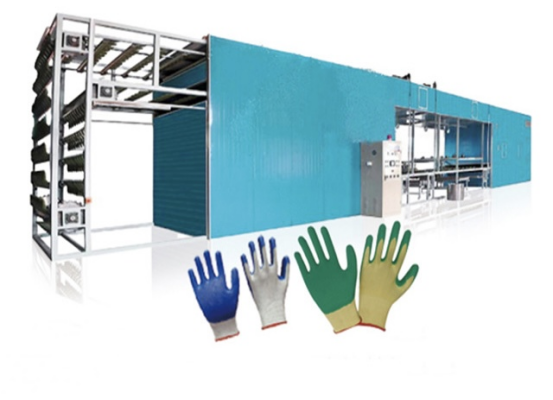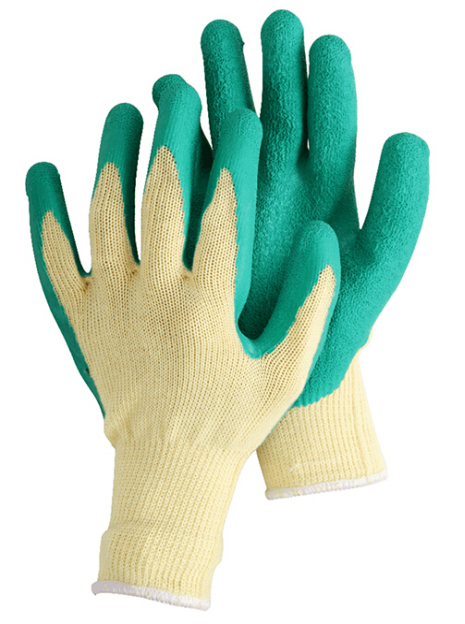Toprisesafety has established itself as a leading latex-coated gloves manufacturer in China, specializing in full-dipped and half-dipped gloves. As safety gloves become increasingly popular, we are sharing insights into the latex-coated gloves manufacturing process below:
Manufacturing Process of Latex-Coated Gloves in China
The process followed by a latex-coated gloves manufacturer in China is highly systematic and automated. Below are the key steps for producing latex-coated gloves.
Raw Material Preparation
The primary raw material for latex-coated gloves is natural latex from rubber trees (Hevea brasiliensis). As a latex-coated gloves manufacturer in China, we import or locally source the latex and then process it with additives like accelerants, stabilizers, and coagulants to improve glove elasticity and durability.
Formulation and Dipping
For latex-coated gloves manufacturing in China, prepare the coating solution by mixing the latex with chemical agents to achieve the right viscosity. Pre-heat the ceramic or metal hand-shaped molds (formers) and then dip them into this solution. The dipping process coats a textile base (usually cotton, polyester, or nylon) with latex, either partially or fully, depending on product specifications.

Coagulation
During this phase, dip the formers into a coagulant solution (often calcium nitrate or calcium chloride), causing the latex to thicken and adhere to the fabric. This is essential for latex-coated gloves manufacturers in China to ensure that the gloves take their final shape.
Curing and Vulcanization
After applying the latex, the gloves undergo curing in a heating oven, a key step for any latex-coated gloves manufacturer in China. This vulcanization process strengthens the latex, making the gloves flexible and durable for industrial or medical use.
Leaching
Washing the gloves to remove excess chemicals and proteins is critical to reducing latex allergies. This step is a key practice for China latex-coated gloves manufacturers to meet global safety standards. Below is a table to show the importance of leaching.
| Aspect | With Leaching | Without Leaching |
| Purpose | Removes excess chemicals, proteins, and impurities. | Retains higher levels of chemicals and proteins. |
| Allergen Reduction | Reduces latex protein content, minimizing allergic reactions. | Higher risk of latex allergies due to unremoved proteins. |
| Chemical Residue | Significantly reduces residual chemicals, making gloves safer. | May contain residual chemicals, which could cause skin irritation. |
| Glove Softness & Comfort | Results in softer, more flexible gloves. | Gloves may feel stiffer and less comfortable to wear. |
| Safety Compliance | Meets higher safety standards, especially for medical use. | May not meet stringent safety or medical standards. |
| Durability | Improved glove durability and flexibility after leaching. | Slightly reduced durability due to retained chemicals. |
| Risk of Contamination | Lower risk of contamination by impurities or chemicals. | Higher risk of contamination, as no cleaning process is involved. |
| Cost of Production | Higher, due to the additional leaching process. | Lower production cost, as no extra process is required. |
| Usage Suitability | Ideal for medical, food handling, and high-safety environments. | Suitable for general, non-sensitive industrial environments. |
| Eco-Friendliness | Wastewater needs treatment, but gloves are safer for end users. | Less water used, but gloves may pose environmental risks due to chemicals. |
Beading
For strength and durability, latex-coated gloves manufacturers in China bead the edges of the gloves after shaping and curing. This ensures that the gloves are easy to put on and remove without tearing.
Drying and Finishing
Thorough drying is crucial in the production process. Some latex-coated gloves manufacturers in China add a textured surface during this stage to improve the gloves’ grip. Additionally, gloves may be chlorinated or powdered for easier donning and doffing.

Stripping
After formation, strip the gloves from the formers using automated machines. This careful process helps latex-coated gloves manufacturers in China avoid damaging the latex coating.
Inspection and Quality Control
Every latex-coated gloves manufacturer in China ensures quality by inspecting each glove for defects like pinholes or uneven coating. Use automated or manual inspections depending on production scale and quality requirements.
Packaging
After quality inspections, count, stack, and package the gloves. Many latex-coated gloves manufacturers in China also offer custom branding and packaging to meet customer requirements.
Environmental and Safety Considerations
As a responsible latex-coated gloves manufacturer in China, Toprisesafety adheres to strict environmental regulations. This includes managing chemical waste and using water recycling systems to reduce environmental impact. To improve sustainability, China latex-coated gloves manufacturers are increasingly adopting energy-efficient technologies in curing ovens and automated dipping lines.
Manufacturing Differences between Latex-coated, nitrile-coated, PVC-coated, and PU-coated gloves
Here is a table comparing the manufacturing differences between latex-coated, nitrile-coated, PVC-coated, and PU-coated gloves:
| Aspect | Latex-Coated Gloves | Nitrile-Coated Gloves | PVC-Coated Gloves | PU-Coated Gloves |
| Material | Natural rubber (latex) | Synthetic rubber (nitrile butadiene rubber) | Polyvinyl chloride (PVC) | Polyurethane (PU) |
| Source of Raw Material | Derived from rubber trees (natural) | Petrochemical-based (synthetic) | Petrochemical-based (synthetic) | Petrochemical-based (synthetic) |
| Allergenicity | High risk of latex allergies | Latex-free (hypoallergenic) | Latex-free, hypoallergenic | Latex-free, hypoallergenic |
| Manufacturing Process | Dipped in natural latex solution, coagulation, curing | Dipped in nitrile latex solution, coagulation, curing | PVC is applied through dipping or spraying; heat is applied for curing | Dipped in polyurethane solution, cured through heating |
| Coating Type | Partial or full latex coating | Partial or full nitrile coating | Partial or full PVC coating | Partial or full PU coating |
| Flexibility & Comfort | Highly flexible, good elasticity | Moderate flexibility and elasticity | Less flexible, thicker, and more rigid | High flexibility, soft feel, excellent dexterity |
| Durability | Good durability, but prone to degradation from oils | Highly durable, oil, and chemical-resistant | Durable, resistant to many chemicals but can be stiffer | Moderate durability, abrasion-resistant, and softer than PVC |
| Chemical Resistance | Limited (less resistant to oils and solvents) | Excellent (resistant to oils, chemicals, and solvents) | Good resistance to acids, oils, and other chemicals | Moderate resistance to oils and solvents |
| Grip & Texture | Often textured for better grip, especially when wet | Can be textured, good grip, even when wet or oily | Smooth or rough texture, less flexible for fine grip | Smooth or lightly textured for good grip |
| Breathability | Poor breathability, traps moisture | Poor breathability, traps moisture | Poor breathability, not suitable for prolonged use | Moderate breathability, better than latex, nitrile, or PVC |
| Environmental Impact | Biodegradable but requires high energy for processing | Non-biodegradable, petroleum-based, but some biodegradable versions available | Non-biodegradable, creates PVC waste, toxic if incinerated | Non-biodegradable, though production may have less toxic byproducts than PVC |
Conclusion
The manufacturing process of latex-coated gloves is widely used in various industries due to the flexibility, comfort, and protective qualities of natural latex. From dipping hand-shaped molds into latex solutions to curing and vulcanization, the process requires precision and careful control over each step to ensure high-quality. However, latex’s potential to cause allergic reactions and its vulnerability to certain chemicals like oils limits its application in some environments. There is a bright future for allergen reductiona, chemical resistance enhancement and environmental sustainability.
To place an order on safety gloves, contact us here.


